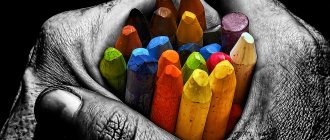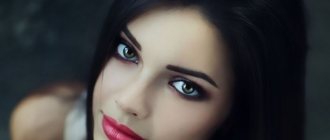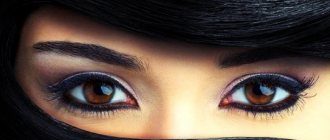Psychologists around the world rightly argue that the choice of clothing color indicates, at a minimum, a person’s momentary mood, and, at a maximum, his vision of himself in society. After all, it has been proven that the brain perceives colors differently and associates them with certain feelings and situations.
What is the psychology of color in clothing?
The psychology of color in clothing explains the choice of a particular color from two points of view:
- the first is the internal state of a person (intuitive choice);
- the second is the impression that the individual wants to make on others (conscious choice).
Often people subconsciously choose the color of their clothes, depending on their psychological state caused by various troubles. This could be troubles at work, frequent conflicts in the family, or simply the mental torment of a person who has not found himself in this life.
With the help of the psychology of clothing, you can manipulate the mood of the public, even to the point of inclining towards the desired point of view. Public people regularly use this, paying a lot of attention to their wardrobe.
The meaning of clothing color in psychology
Psychology believes that contemplation of color has an impact on the human psyche, including sudden mood swings. Therefore, it is important to choose an outfit so that it does not irritate either the owner or others during the day.
Red
Psychology considers a lover of the color red in clothes as an extraordinary, strong personality with clearly expressed leadership qualities. This is the color of love and passion, on the one hand, and aggression, on the other. A person who prefers red is impulsive, ambitious, often assertive and selfish.
Orange
Although orange shades in the spectrum are adjacent to red, this color has the opposite meaning. Orange lovers are intellectually developed, active, good-natured and sociable. A rich orange tone is difficult for the brain to perceive, causing psychological exhaustion, so you should wear such tones with care.
Yellow
In psychology, the color yellow in clothing is associated with the sun, warmth, and cheerfulness. Yellow has a positive effect on mental activity, fights chronic fatigue and prolonged depression. People who love this shade are always in a good mood, open and sociable. However, they are often very critical of themselves and others.
Green
Green symbolizes assertiveness, toughness and firmness. The choice of green clothing speaks of a person’s desire for constancy, his desire to assert himself. At the same time, green lovers subconsciously want to be liked by others; they lack public recognition.
Blue
Blue has a dual effect on the human psyche. On the one hand, this color calms, on the other hand, if it is not diluted with other tones, it causes anxiety and even a state of depression. People who choose outfits in blue tones are distinguished by reliability and calmness.
Blue
Blue is associated with the sky, sublimity, and spirituality. Blue evokes trust and respect and promotes a feeling of peace. People wearing blue clothes are intellectually developed, creative and positive. It is easy to find a common language and establish contact with them.
Lilac
The lilac color in clothes psychologically causes feelings of anxiety and concern in others. You should not wear lilac tones when going to negotiations, as the interlocutor may feel rejected. Lilac lovers are people prone to melancholy and depression. Surrounding themselves with lilac tones, they unconsciously plunge deeper into a state of depression.
Violet
The psychology of purple in clothing speaks of a person’s desire to be realized in this life. People who prefer purple shades are critical of themselves, prone to self-control, but at the same time they are in dire need of support and support. They are sentimental and sensitive. Saturated purple shades can cause apathy, as they put significant pressure on the psyche.
Pink
Pink shades relieve irritation, pacify anger, and have a relaxing effect on the psyche. Pink lovers need protection and love. Such people are easily excitable and often become restless for any reason. They are frivolous, looking for vivid sensations and impressions.
Grey
Psychology explains the choice of gray in clothing by the desire not to stand out, to be inconspicuous. People who dress in shades of gray are afraid of being seen and often have low self-esteem. At the same time, they are open, good-natured, responsible, you can rely on them and trust them.
White
In psychology, white clothing is associated with purity and perfection. People who often wear white clothes are neat, punctual, decent and sincere with others. This color has a positive effect on the human psyche and makes people feel good about themselves; it’s not for nothing that health workers wear white coats.
Black
Psychology explains an excess of black in clothes with self-doubt and the desire to hide from the surrounding reality. Often this indicates mental anguish, internal depression, melancholy and a state close to depression. However, this is not always the case. Psychology explains the color black in a woman’s clothing as aggressiveness towards others. With this she wants to show independence and self-sufficiency. For men, it is a symbol of rigor, efficiency, and practicality.
Brown
In psychology, the brown color of clothing symbolizes earth, life, and fertility. People who prefer brown tones clearly know their goals and go towards them. They are success-oriented, practical and serious, and indulgent towards dreamers. Brown brings a sense of stability, suppresses anxiety and restlessness.
White color in clothes: true or false?
Surely you have heard more than once that white makes you look fat and there is truth in this, because visually it adds volume. But you shouldn’t listen to all the rumors and opinions, so the time has come to debunk the existing myths about the color of white clothes.
- Fat women and white clothes are not compatible . Of course, there is some truth in this, but it does not mean that all ladies who are overweight should deny themselves such a good thing as white clothes. If the item is chosen correctly and matches the silhouette and body type, then white, on the contrary, will be a profitable solution. A vest with a V-neck, which will be combined with a pencil skirt and a simple blouse, will allow you to achieve slimness. For ladies with small breasts, a white shirt or top will visually add volume to the chest. If you have full hips that stand out in your figure, you should avoid a white bottom.
- White color is suitable only for young girls. Another myth about white that you shouldn't believe. Even if you have gray hair, you can confidently wear white clothes.
- White suits only brunettes and brown-haired women, as well as fair-haired girls. You should not believe this assertion, because much in modern fashion depends on the quality of the item, style, makeup and other factors. Of course, the contrast of dark skin and dark hair paired with a white T-shirt or sweater is magnificent, but even red-haired beauties can afford a white dress or jacket.
In short, there is no reason to refuse to wear white. If you have a sense of style and know how to combine colors, you should not refuse light-colored clothes!
The concept of warm and cold colors in psychology
Psychologically, a person divides all shades into warm and cold. Warm - shades with a predominance of red and yellow. Cool - shades with a predominance of blue and green.
To perceive warm tones, the human eye expends more energy, because these tones have the longest wavelength. An outfit in which warm colors predominate stimulates the brain, at the same time increasing the heart rate and breathing. Therefore, easily excitable people should not wear clothes in rich, warm colors.
Cool tones, on the contrary, have a short wavelength and are easily perceived by the eye. Clothing with a predominance of cool colors calms, slows down metabolism, and protects against rash, impulsive actions.
The meaning of red in psychology
The color red has attracted people's attention since ancient times. It was considered exciting and served as a danger signal. For many peoples, it was associated with power, so it was used by rulers. Nowadays it is often used in advertising because it attracts attention and calls to action. Science has proven its stimulating effect is related to the wavelength.
Photo: wallpaperplay.com
It is believed that the color red stimulates activity, increases efficiency and improves mood. It causes a surge of energy as it increases your heart rate. And its excess can even cause an increase in blood pressure. In some people, it leads to anxiety, outbursts of aggression, and irritability.
Psychology studies the influence of colors on character. It has been noticed that a person can avoid some shades, preferring others.
Those whose favorite color is red have the following characteristics:
- they are strong-willed, purposeful, and do not retreat from difficulties;
- energetic and efficient;
- they are leaders and can lead others;
- in relationships with the opposite sex they are also active;
- stubborn and persistent, get their way;
- but they are intolerant, it is difficult for them to compromise;
- The negative qualities of such people include cruelty and a tendency to violence.
Psychology of color in men's clothing
The choice of this or that shade by a man indicates his life aspirations and desire to make a certain impression on others.
Psychology considers the presence of red in a man’s clothes as his desire to show his superiority over others. This is a symbol of power. Often wearing red, a man seeks to attract the attention of the lady he likes.
The psychology of black clothing speaks of strength of character and iron will. By dressing in black, a man demonstrates his determination and authority.
Blue tones will give a man seriousness and help him gain the trust and sympathy of others.
Psychology of color in women's clothing
Women spend significantly more time choosing their wardrobe than men. Intuitively, with the help of the main tone of the outfit, they convey to others their desire to either stand out or go into the shadows.
For example, the predominance of red in a woman’s clothing indicates her unconscious influence on the men around her. By doing this, the girl tries to look more attractive in the eyes of the stronger sex, which indicates her dissatisfaction with her personal life. Nevertheless, dark and pastel colors do not always indicate depression, because the choice of outfit is largely influenced by both the momentary mood and the character of the person.
In addition, women of all ages are inherently quite emotional and are capable of acquiring something completely uncharacteristic for them. That’s why almost every woman’s wardrobe is often full of colors and the style changes depending on her mood.
White color in fashion history and different cultures
It is common for us to consider white to be the best color for a bride’s wedding dress. In the modern Western world, it is traditionally associated with purity, innocence, and freshness. In advertising and design, white is used as a symbol of novelty and high quality. But this was not always the case and not everywhere. For example, in eastern countries, white is the color of mourning and grief; clothes in its shades are worn at funerals.
white color in wedding fashion
The fashion for white outfits came to Russia from France. The famous Josephine loved this color very much and for good reason, because it set off her porcelain-pale skin incomparably. Later, the white color was overthrown from the pedestal of fashion, it was supplanted by more saturated and rich colors. The lightest color was branded in high society as overly modest and boring, called the color for the poor.
The 20th century, with its heyday of cinema, once again returned white to the list of favorites. But now it would no longer be a symbol of tenderness and charm; white dresses have become a way of expressing sensuality. The best example of this is Marilyn Monroe's famous pleated skirt outfit from the film The Seven Year Itch. The legendary blonde embodied one of the most memorable sexy images in the history of cinema and did it with the help of a flowing white dress.
white dress in a sexy image of Marilyn Monroe
Later in the 50s and 60s, shades of white again won the favor of the elite segments of society. They have become favorites for country holidays, beach trips and aristocratic sports such as tennis or yachting.
In our era, white still experiences periods of popularity and decline, but to a noticeably lesser extent than before. Its shades are an important part of the basic wardrobe for all women without exception.
Psychology of color in children's clothing
The psychology of color in a child’s clothing has a very subtle effect on the child’s psyche. Children perceive the colors around them more keenly than adults, so you need to be careful when choosing children's things. Too bright colors can cause anxiety in the baby, he will be capricious and cry.
It is not recommended to dress a child in red, orange and purple tones until he is one year old. They suppress the psyche and negatively affect the development of the child. Yellow, pink and blue shades would be ideal. They soothe, give a feeling of warmth and tenderness.
The right choice of clothing directly affects the mood of others and creates the first impression of a person. Therefore, this must be taken seriously. After all, people often judge their interlocutor by their appearance, and the wrong wardrobe can ruin everything.











